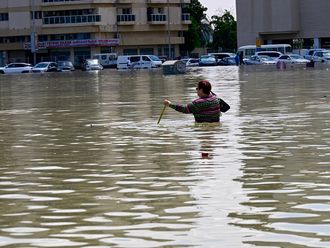Dubai: 2016 broke multiple records by being the warmest year on record, with exceptionally low sea ice and an unabated rise in sea levels, according to the World Meteorological Organisation (WMO).
This year seems to be heading in the same direction, it added.
The WMO issued its annual statement on the State of the Global Climate ahead of World Meteorological Day celebrated every year on March 23.
The report is based on multiple international datasets maintained independently by global climate analysis centres and information submitted by dozens of WMO members.
“This report confirms that 2016 was the warmest on record — a remarkable 1.1 degrees Celsius above the pre-industrial period, which is 0.06C above the previous record set in 2015. This increase in global temperature is consistent with other changes occurring in the climate system,” WMO Secretary-General Petteri Taalas said.
“Globally averaged sea surface temperatures were also the warmest on record, global sea levels continued to rise, and Arctic sea-ice extent was well below average for most of the year,” he added.
With levels of carbon dioxide in the atmosphere consistently breaking new records, the influence of human activities on the climate system has become more and more evident, Taalas explained.
Each of the 16 years since 2001 has been at least 0.4C above the long-term average for the 1961-90 base period, used by WMO as a reference for climate change monitoring.
Global temperatures continue to be consistent with a warming trend of 0.1C to 0.2C per decade, according to the WMO report.
The strong El Nino event experienced in 2015 and 2016 boosted temperature increase in 2016, on top of long-term climate change caused by greenhouse gas emissions.
Global sea levels rose very strongly during the El Nino event, with the early 2016 values reaching new record highs.
Global sea ice extent dropped more than four million square kilometres below average in November, an unprecedented anomaly for that month.
The very warm ocean temperatures contributed to significant coral bleaching and mortality was reported in many tropical waters, with important impacts on marine food chains, ecosystems and fisheries.
Carbon dioxide levels in the atmosphere reached the symbolic benchmark of 400 parts per million in 2015 — the latest year for which WMO global figures are available — and will not fall below that level for many generations to come because of the long-lasting nature of CO2.
Newly released studies, which are not included in WMO’s report, indicate that ocean heat content may have increased even more than previously reported. Provisional data also indicates that there has been no easing in the rate of increase in atmospheric carbon dioxide concentrations.
“Even without a strong El Nino in 2017, we are seeing other remarkable changes across the planet that are challenging the limits of our understanding of the climate system. We are now in truly uncharted territory,” said World Climate Research Programme Director David Carlson.












